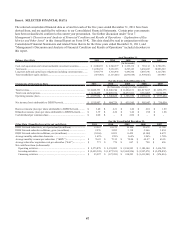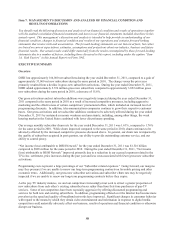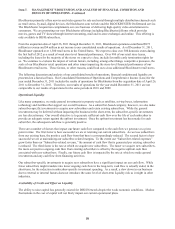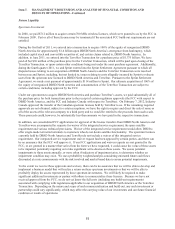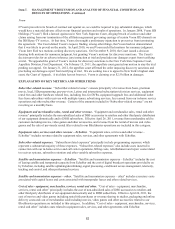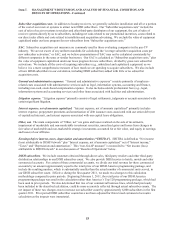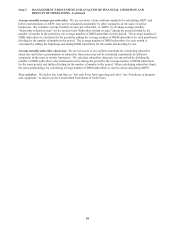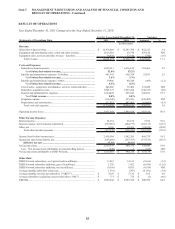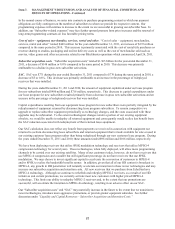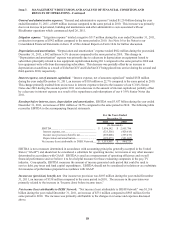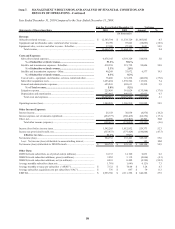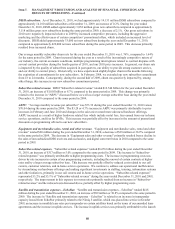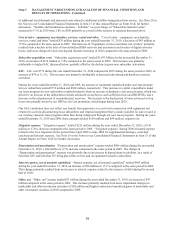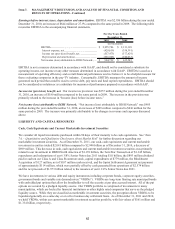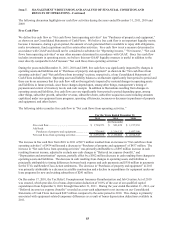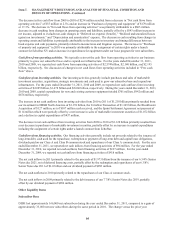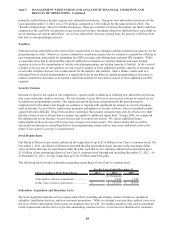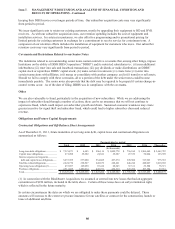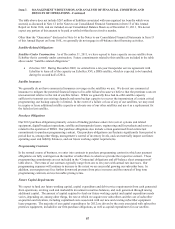Dish Network 2011 Annual Report Download - page 67
Download and view the complete annual report
Please find page 67 of the 2011 Dish Network annual report below. You can navigate through the pages in the report by either clicking on the pages listed below, or by using the keyword search tool below to find specific information within the annual report.
Item 7. MANAGEMENT’S DISCUSSION AND ANALYSIS OF FINANCIAL CONDITION AND
RESULTS OF OPERATIONS - Continued
57
57
In the normal course of business, we enter into contracts to purchase programming content in which our payment
obligations are fully contingent on the number of subscribers to whom we provide the respective content. Our
programming expenses will continue to increase to the extent we are successful in growing our subscriber base. In
addition, our “Subscriber-related expenses” may face further upward pressure from price increases and the renewal of
long-term programming contracts on less favorable pricing terms.
Cost of sales – equipment, merchandise, services, rental and other. “Cost of sales – equipment, merchandise,
services, rental and other” totaled $449 million for the year ended December 31, 2011, an increase of $372 million
compared to the same period in 2010. This increase is primarily associated with the cost of rental title purchases or
revenue sharing to studios, packaging and on-line delivery costs as well as the cost of merchandise sold such as
movies, video games and other accessories related to our Blockbuster operations which commenced April 26, 2011.
Subscriber acquisition costs. “Subscriber acquisition costs” totaled $1.505 billion for the year ended December 31,
2011, a decrease of $148 million or 9.0% compared to the same period in 2010. This decrease was primarily
attributable to a decline in gross new subscriber activations.
SAC. SAC was $771 during the year ended December 31, 2011 compared to $776 during the same period in 2010, a
decrease of $5 or 0.6%. This decrease was primarily attributable to an increase in the percentage of redeployed
receivers that were installed.
During the years ended December 31, 2011 and 2010, the amount of equipment capitalized under our lease program
for new subscribers totaled $480 million and $716 million, respectively. This decrease in capital expenditures under
our lease program for new subscribers resulted primarily from a decrease in gross new subscriber activations and an
increase in the percentage of redeployed receivers that were installed.
Capital expenditures resulting from our equipment lease program for new subscribers were partially mitigated by the
redeployment of equipment returned by disconnecting lease program subscribers. To remain competitive we
upgrade or replace subscriber equipment periodically as technology changes, and the costs associated with these
upgrades may be substantial. To the extent technological changes render a portion of our existing equipment
obsolete, we would be unable to redeploy all returned equipment and consequently would realize less benefit from
the SAC reduction associated with redeployment of that returned lease equipment.
Our SAC calculation does not reflect any benefit from payments we received in connection with equipment not
returned to us from disconnecting lease subscribers and returned equipment that is made available for sale or used in
our existing customer lease program rather than being redeployed through our new customer lease program. During
the years ended December 31, 2011 and 2010, these amounts totaled $96 million and $108 million, respectively.
We have been deploying receivers that utilize 8PSK modulation technology and receivers that utilize MPEG-4
compression technology for several years. These technologies, when fully deployed, will allow more programming
channels to be carried over our existing satellites. Many of our customers today, however, do not have receivers that
use MPEG-4 compression and a smaller but still significant percentage do not have receivers that use 8PSK
modulation. We may choose to invest significant capital to accelerate the conversion of customers to MPEG-4
and/or 8PSK to realize the bandwidth benefits sooner. In addition, given that all of our HD content is broadcast in
MPEG-4, any growth in HD penetration will naturally accelerate our transition to these newer technologies and may
increase our subscriber acquisition and retention costs. All new receivers that we purchase from EchoStar have
MPEG-4 technology. Although we continue to refurbish and redeploy MPEG-2 receivers, as a result of our HD
initiatives and current promotions, we currently activate most new customers with higher priced MPEG-4
technology. This limits our ability to redeploy MPEG-2 receivers and, to the extent that our promotions are
successful, will accelerate the transition to MPEG-4 technology, resulting in an adverse effect on our SAC.
Our “Subscriber acquisition costs” and “SAC” may materially increase in the future to the extent that we transition to
newer technologies, introduce more aggressive promotions, or provide greater equipment subsidies. See further
discussion under “Liquidity and Capital Resources – Subscriber Acquisition and Retention Costs.”


